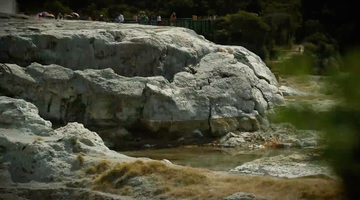In this video, educator Angela Schipper demonstrates how to build a model of an aquifer – a layer of rock or other material that carries water underground. This is an excellent activity that needs only a few easy to organise resources.
Point of interest
Teachers may want to ask students why the water does not simply disappear in the ground. (Not all rock layers in the ground are equally porous – some are impermeable).
Nature of Science
Scientists make use of models to test predictions. Models allow scientists to test a range of scenarios. without potentially harming the environment.
Transcript
NARRATOR
We know when rain falls on hard surfaces, it gathers in puddles and eventually evaporates. But what happens to water that pours onto a garden or a paddock? We are going to make an aquifer model to see the part of the water cycle that happens beneath our feet. These are the materials we will need to set it up. An aquifer is a layer of rock or other material that carries water underground. Real aquifers are made of geological materials like sand, pumice or fractured rock. We are going to use aquarium stones. We will slope the stones because we want to have a lake at one end of our model. We can’t see aquifers because they are beneath the surface, so we will add a layer of soil, pat the soil down a bit because we don’t want too much erosion, then we will place a layer of grass clippings on to represent vegetation. Now, let’s make it rain. Use a cup with holes punched in the bottom so it provides a gentle flow. Watch what happens to the coloured water as it hits the soil. Some of it runs off on the surface into the lake right away. Some of the rain moves down through the soil and begins to fill up the aquifer. We can see a lake is forming in the depression we made. The lake is fed directly by rain through run-off and also by water moving through the aquifer. The top of the saturated layer of our model is called the water table. The water table fluctuates depending upon how much water enters into or is discharged from the aquifer. Groundwater is used extensively for drinking water and irrigation. To obtain the water, we need to drill a well deep enough to penetrate the water table. Use a spray pump to represent a bore or municipal well.
Acknowledgement:
Dr Ravi Gooneratne, Lincoln University



